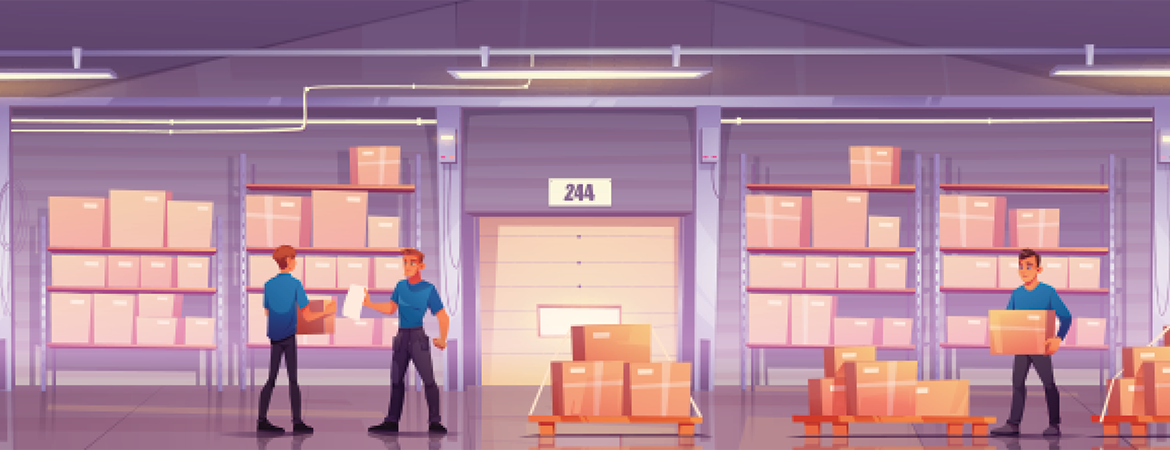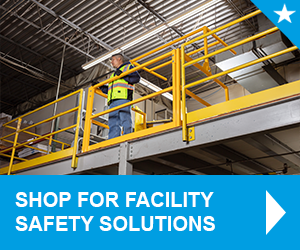
During year-end inventory, warehouses and distribution centers experience renewed activity largely at odds with their normal rhythms. That’s why it’s important to anticipate these changes and optimize your industrial safety equipment beforehand. We’ll discuss how the right custom safety gate, modular rail for equipment or other OSHA fall safety equipment can counter the tendency for employees to take unsafe risks as their attention narrows.
Assessing the Scope of Inventory Challenges
Each warehouse or distribution center is inherently unique, both due to floorplan differences and the types of commodities they store. Even though regular employees know their way around, only those with the most experience know what to expect during inventory. Long hours, crowded areas, and temporary workforces all contribute to new challenges that test the efficacy of OSHA fall safety equipment.
For staff and managers alike, it seems no amount of preparation can truly mitigate the mild chaos that ensues. However, there’s more under your control than not. Upgrading your fall protection procedures will ensure your inventory counts go as safely as possible and with minimal strain on available resources.
Which Fall Risks Increase During Inventory?
In addition to overall workflow irregularity, there are several specific fall risks safety managers should keep their eyes on during end-of-year inventory counts:
- Increased portable ladder use to reach tall industrial shelves
- Frequent lifting of heavy, bulky objects in crowded areas
- Increased foot traffic on elevated spaces and stairways
- More trip hazards, such as broken-down pallets, pallet jacks, and debris
- Increased activity on mezzanines and other elevated storage platforms
- Forklift operations in the same vicinity as staff
- Overall greater distraction and tunnel vision
Choosing the Right Industrial Safety Equipment for Your Risks
We’ve covered inventory safety protocols for general industry in the past, in which we identified the following fall safety risks that become more urgent during inventory. Here, we’ve expanded that list by including the likeliest OSHA regulations you may need to reference as you optimize your fall protection procedures.
- Stairs and Ladders: Ensure stairs and stair handrails meet OSHA 1910.25 and 1910.28[b][11], respectively, and look for any signs of disrepair. OSHA 1910.23 covers ladder requirements for walking-working surfaces, and 1926.1053 describes more general requirements for fixed and portable ladders. Pay special attention to the load limits for ladders, and ensure all staff know them as well. For stairs and fixed ladders, remove debris, improve lighting, and maintain good traction at upper and lower access points. This is easier by replacing chains or other non-rigid members with self-closing swing gates. Such gates are also suitable for mobile ladder stands and mobile ladder stand platforms (per 1910.23[e]), a common element in storage facilities.
- Catwalks: Warehouses often use catwalks in tandem with pallet drops, conveyor systems, and elevator-like devices to more efficiently move heavy items between levels. For these and lighter uses of elevated working platforms, it’s essential to protect all leading edges with integrated modular guardrails. Ensure they’re 42 in. (106.7 cm) tall, + or – 3 in. (7.6 cm), and built to withstand 200 lb. (890 N) of force at the top rail and 150 lb. (150 N) at any midrail. See OSHA 1910.29[b] for full dimensional and force-rating standards. Compared to permanent railing, modular guardrails contribute to greater workplace adaptation. The ability to quickly change one type of railing for another ensures your leading edge protection adapts to changing workflows.
- Loading Docks: It may be in your best interest to limit shipments as much as you can during inventory. If you can’t, look for places where modular guardrails could maintain safer workflows, along with their primary function of protecting leading edges at loading bay openings. Ramp edges are also good locations for guardrails. Even if a ledge is under the general 4 ft (1.2 m) requirement for fall protection, consider placing them anywhere a trip hazard may arise. A twisted ankle while carrying loads or in the presence of heavy machinery is all it takes to cause significant injury.
- Dangerous Machines: When combined with a safety gate, a modular rail for equipment is the most effective way to meet OSHA machine guarding requirements. If your warehouse uses packaging, palletizing, or any other machines, inspect them for recognized hazards, including sharp edges, electric shocks, or crushing motions, and block them from access, even if they’re at ground level or below an accessible elevated area.
- Mezzanines: In warehousing and other storage facilities, mezzanines are important means of storing materials and equipment. Compared to industrial shelving, a mezzanine can be much easier to use, since it allows workers to more directly engage with materials. However, this presents additional risk that must be addressed. Most warehouses have an easy time meeting fall protection requirements for walking-working surfaces, including mezzanines (outlined in 1910.28). Where many facilities struggle, however, is loading and unloading, where ineffective methods expose workers to the leading edge just as they receive large, heavy loads. Mezzanine swing gates utilize a counter-balanced dual-gate design, where one gate’s opening automatically closes the other. This maintains a barrier between workers and the leading edge, even as a forklift delivers its load. Once complete, the outer gate closes as the inner gate opens, granting workers safe access.
It’s important to note that the regulations listed above are for general industry at the federal level. Nearly half of all states have chosen to develop their own state plan. They normally match, and often even exceed, federal OSHA requirements, but the exact regulations may be different.
Thus, it’s crucial to consult local, OSHA, or Canada’s CCOHS requirements as relevant to your specific location and industry. In the end, full safety compliance depends on you and your team, and it cannot be outsourced.
Deciding When to Go Beyond the Requirements
Sometimes, warehouse safety managers have reason to go beyond the minimum standards when selecting OSHA fall safety equipment. While OSHA doesn’t authorize or endorse any specific product, fall protection manufacturers are free to verify and advertise that their products comply with OSHA standards.
Leading manufacturers often surpass these standards, and safety managers can apply OSHA-compliant products where they see fit (so long as it doesn’t cause some additional hazard, like allowing a gate to open directly into another hazard). Once you’re confident in your OSHA fall protection measures, don’t hesitate to apply the same equipment to resolve various other workflow and safety needs, including:
- Modular guardrails/gates for any access control need
- An adjustable custom safety gate for variable-width openings
- Vertical lift gates at the top of cramped stair platforms, loading docks, or anywhere a horizontal swinging gate may be disruptive
- Universal-mount gates compatible with flat, round, square, and other railing
- Guardrails set beyond loading and unloading zones to keep workers away from heavy equipment
- Full coverage gates where adjacent railing requires toeboards (to prevent falling objects)
Bridging the Gap Between Warehouse Efficiency and Compliance
Deciding on the right custom safety gate or modular rail for equipment depends on a thorough understanding of where your facility’s fall protection needs overlap with regulatory requirements. For warehouses and distribution centers, those needs become uncomfortably apparent during year-end inventory activities.
Don’t let it get to that point. Even if time is short, you can quickly enhance your fall safety by reaching out to a dedicated and experienced fall protection manufacturer. As a trusted expert in custom industrial safety equipment for nearly a half-century, Fabenco takes a concerted look at a given industry’s unique fall protection requirements.
Our equipment is designed to meet the widest possible range of the most common fall safety regulations. To discuss your warehouse fall protection and industrial safety equipment needs, contact us, and tell our knowledgeable engineers about your facility’s specific safety and workflow requirements.





